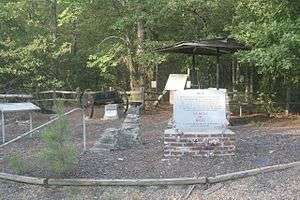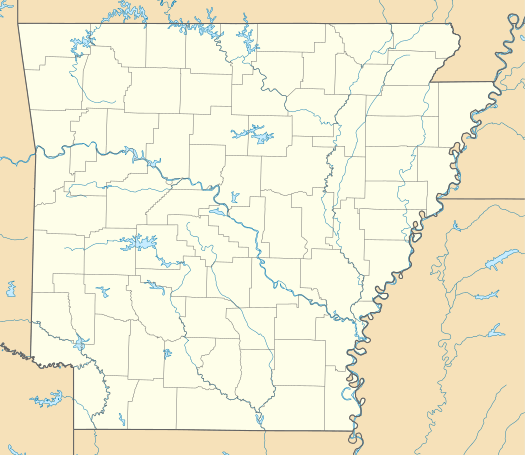Battle of Marks' Mills
| ||||||||||||||||||||||||||||||||
| ||||||||||||||||||||||||||||||||
The Battle of Marks' Mills (April 25, 1864) occurred in present-day Cleveland County, Arkansas as part of the American Civil War. Confederate Brigadier-General James Fagan, having made a forced march, attacked a train of several hundred wagons, guarded by a brigade of infantry, 500 cavalry, and six pieces of artillery, on its way from Camden to Pine Bluff for supplies.
Background
Following the Federal defeat at the Battle of Poison Spring on April 18, 1864, Major-General Frederick Steele retained possession of Camden while Confederate Major-General Sterling Price continued his ad hoc siege upon Camden from the countryside. As Federal provisions diminished, arrival of much-needed supplies from Pine Bluff convinced Steele that more could be obtained using the Camden-Pine Bluff Road. Steele ordered Drake with over 1,400 infantrymen, artillery and cavalry support, and 240 wagons to obtain supplies from Pine Bluff. Reinforced on the morning of April 25, 1864 by some 350 additional troops, Drake's command contained approximately 1,800 combatants, including the 43rd Indiana, 36th Iowa and the 77th Ohio plus additional cavalry and artillery. An unidentified number of civilians accompanied the column.
The 43rd took the lead, with the wagon train stretching more than a mile along muddy forest roads.[1] Encountering mirey ground along the rain-swollen Moro River, Colonel Drake chose not to push through to Pine Bluff, and instead camped about eight miles outside of town.[2] He did so unaware that two brigades of Price's cavalry with over 5000 troopers were nearby.[3] Though Major Wesley Norris tried to warn Drake of movement in the woods to his front during the night, Drake laughed off his concerns and told Norris—a combat veteran of the Mexican War—that he "got scared too easily."[4]
Battle

Early on the morning of 25 April 1864, following a difficult crossing of the Moro, the 43rd and its sister units resumed their march toward Pine Bluff. Soon the 43rd encountered several abandoned Confederate campsites to their front, but reports of a large Confederate presence in the area were discounted by Drake, who "roundly" cursed Major Norris and ordered the regiment to pick up its pace.[5] As the 43rd emerged into a small clearing known as Mark's Mills, it was attacked by Fagan's dismounted brigade, including the 1st Arkansas Cavalry.[6] The Hoosiers drove the Southerners back, but were quickly hit on their right flank by additional Confederates under the command of Brigadier-General William Cabell. The 43rd, supported by the 36th Iowa, now found itself facing the 1st Arkansas, together with the 2nd Arkansas and Thomas Gunter's cavalry battalion.[7] The 43rd and 36th were forced back toward a few log cabins in the center of the clearing, where their artillery raked the oncoming Southerners and was blasted in return by Hugely's Arkansas Battery.[8]
Just when it seemed that things could not get worse, the 43rd and 36th were now hit on their left flank by Jo Shelby's cavalry, and found themselves fighting an overwhelming force (outnumbering them two-to-one) attacking from three directions at once. Of the 33 members of the 43rd's Co. G who went into the fight, 23 were killed or wounded within the first thirty minutes.[9] Despite valliant efforts by the 77th Ohio and the 1st Iowa Cavalry to prevent the ensuing encirclement, the Federals found themselves surrounded in the clearing and fighting for their lives. The battle lasted for four hours altogether,[10] until they were finally compelled to surrender. One supporting artillery battery was reportedly wiped out to the last man, with its mortally-wounded Lieutenant firing a final gun into the oncoming Rebels before succumbing to his injuries.[11]
According to Sergeant John Moss of the 43rd Indiana's Co. G, the regiment did not give up en masse; rather, continual charges by the Southerners resulted in the capture of small numbers of men each time, until only about 50 of the 43rd remained who had not been killed, wounded, run off or captured. When asked by these last remaining troops to surrender them, Norris refused, saying he would never surrender anyone but himself—and that only if he was forced to. He and the others made for the woods, but Norris' horse was shot out from under him and he lost a boot; he and his comrades were finally forced to give up only 100 yards from Shelby's command.[12] 211 members of the 43rd were taken prisoner; others managed to escape and made their way back to Steele's main force.[13]
Aftermath
The Confederates estimated 41 killed, 108 wounded, and 144 missing. The Federal numbers are more difficult to determine because the entire column was captured; approximations range from 1,133 to 1,600. Additionally, the Confederates seized 150 African Americans and were accused of killing at least 100 others during or after the assault.[14] The loss of additional men and wagons, as well as the further depletion of Federal supplies in Camden, seriously challenged Steele's position and combined with the arrival of Lt. Gen. Kirby Smith's command to force Steele to abandon Camden on April 26, 1864, and march northward toward Little Rock.
Following the battle, a Federal soldier in the 36th Iowa commented that, "The Rebs robbed nearly every man of us even to our chaplain. They stripped every stitch of clothes, even their shirts, boots and socks, and left the dead unburied and the woods on fire. Clothing was also pulled from the wounded as they begged for mercy. No respect was given for persons rank or age. Old Captain Charles Moss of the 43rd Indiana Infantry was marched bareheaded with his bald head and white locks and beard in the burning sun." Federal records indicate that some 190 infantrymen and cavalrymen escaped and made their way overland to report in at the Federal Depot at Pine Bluff or made it all the way to Little Rock. Colonel William McLean, commanding the brigade of which the three Federal regiments had been a part, wrote that some captured prisoners were stripped and forced to march into captivity completely naked.[15] The Confederates reportedly left the Federal dead on the field for three days before any attempt was made to bury them, according to McLean.[16]
Most of the soldiers captured from the 36th Iowa, 43rd Indiana, 77th Ohio and Peetz's Battery of the 1st Missouri Light Artillery were marched to Tyler, Texas, where they were incarcerated at a prison stockade at Camp Ford. Many died there over the next year from malnutrition and disease, but there were several successful escapes. Most of the prisoners remaining alive were released in 1865.
The 43rd Indiana's regimental history tells of a Federal paymaster with over $175,000 in Greenbacks among those captured at Mark's Mills; the money fell into Confederate hands, and was supposedly used by Southern authorities in a futile attempt to purchase the freedom of Confederate prisoners confined in Chicago.[17]
Cabell paid tribute to the courage and tenacity exhibited by his enemies during the battle. "Men," he wrote, "never fought better. They whipped the best infantry regiments that the enemy had—'old Veterans', as they were called... The killed and wounded of Cabell's Brigade shows how stubborn the enemy was, and how reluctantly they gave up the train."[18] Neverthtless, the debacle at Mark's Mills is considered by some historians to be the worst defeat ever suffered by Federal forces west of the Mississippi.[19]
Ironically, the disastrous defeat at Mark's Mills was credited with saving the remainder of Steele's army from annihilation. Fagan and Shelby had been ordered to get between Steele's force and its original base at Little Rock; had they done so, there is no question that their overwhelming numbers, combined with additional units advancing under their commander Kirby Smith, would have surrounded Steele and compelled his destruction or surrender. By disobeying General Smith's orders and engaging Drake's brigade at Mark's Mills, Shelby and Fagan caused a delay in the Rebel advance that proved to be just long enough for Steele to evacuate Camden and lead the battered remnants of his force to safety.[20] Although Colonel Drake would later go on to a successful political career in his home state of Iowa, including winning the governorship of that state, the regimental historian of the 36th Iowa wrote that the men of the 43rd Indiana held him in extreme contempt long after the war, for "leading them straight into ambush by his dithering indecisiveness" at Mark's Mills.[21]
See also
Notes
- ↑ McLean, pg. 48.
- ↑ McLean, pg. 42.
- ↑ McLean, pg. 22.
- ↑ McLean, pg. 42.
- ↑ McLean, pp. 42-43.
- ↑ Baker, pg. 17.
- ↑ Baker, pg. 17.
- ↑ Baker, pg. 17.
- ↑ McLean, pg. 49.
- ↑ McLean, pg. 49.
- ↑ McLean, pg. 49. McLean says that the battery was wiped out, but Baker says they (assuming both were talking about the same battery) were forced to take cover under some log cabins, where they were later captured by the Confederates. Baker, pg. 18.
- ↑ McLean, pg. 49-50, 118.
- ↑ McLean, pp. 22-23.
- ↑ Arkansas Encyclopedia - Battle of Mark's Mills. See also Baker, pg. 18.
- ↑ McLean, pg. 50.
- ↑ McLean, pg. 50.
- ↑ McLean, pg. 23.
- ↑ After-Action Report of General Cabel.
- ↑ Mark's Mills Battle Site, pg. 9.
- ↑ McLean, pg. 24, 52.
- ↑ History of the 36th Iowa Infantry Regiment, under "Post Script".
References
- Baker, William D. The Camden Expedition of 1864. Arkansas Historic Preservation Program.
- McLean, William E., Colonel: The Forty-Third Regiment of Indiana Volunteers: An Historic Sketch of Its Career and Services. (Terre Haute, C.W. Brown) 1903.
- Photo of Wesley Norris from the original by Mike Leahan
External links
- Battle of Marks' Mills at the American Battlefield Protection Program
- Battle of Marks' Mills at Encyclopedia of Arkansas History & Culture
| ||||||||||||||||||||||||||||

